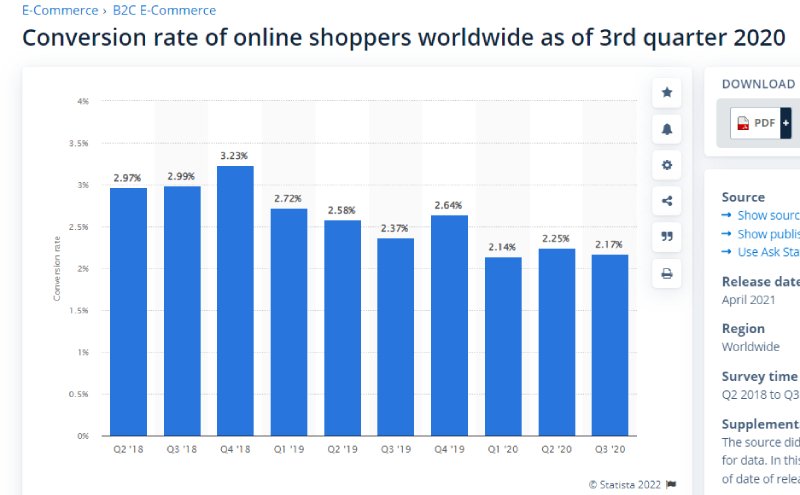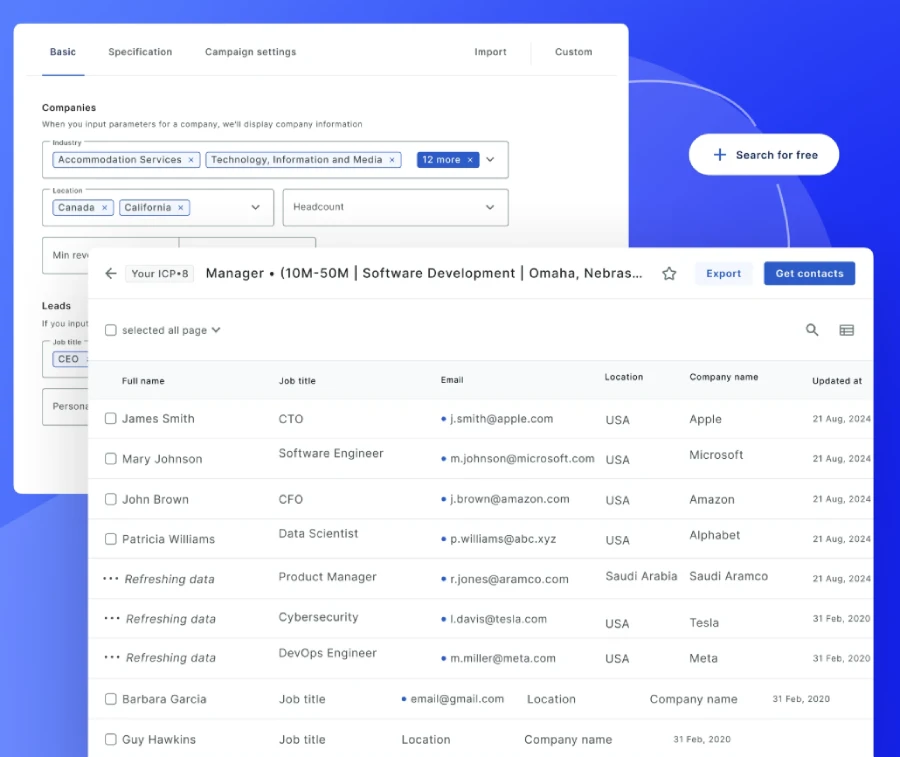
How To Increase ECommerce Conversion Rate?
Did you know that the average ECommerce conversion rate ranges from 1 to 4%? So, if you manage to increase your ECommerce conversion rate even by 1%, you’ll be able to pull a significant sales number.
But the fact remains – How?
We have a few ECommerce hacks up our sleeves to improve your ECommerce business conversion rates.
But before we discuss how to increase the conversion rate for ECommerce, it’s essential to know the Whats and the Whys.
What Is An ECommerce Conversion Rate?
ECommerce conversion rate is the percentage of website visitors turned into customers. The rate lets you know how much traffic you require to make n number of sales. The formulae to measure ECommerce conversion rate is:
Total number of sales ÷ Total number of website visitors = Conversion rate
Why Do You Need To Increase Conversion Rates?
There are two ways to answer this question. One is as simple as increasing sales, and the other has more arguments in support. Have a look.
Get ROI On Resources Spent On Marketing
Bringing traffic to your website includes PPC ad campaigns, which take up a considerable chunk of your capital. So, to get your money’s worth, you need to convert as many visitors into customers.
After all, you spent all that money to bring more eyeballs to your website to increase sales.
Improves Website And Its Performance
High conversions depend on a well-designed and managed sales funnel. Everything from marketing campaigns, your website, mobile app to the sales process needs to be in sync to increase sales.
So, in the search for driving conversions, you’ll discover the crucial areas of your website that contribute to converting visitors into customers.
Conversion Rates Help Keep Businesses On Track
Conversion rates serve as a crucial metric for ECommerce businesses to see how they are doing in sales. If a website has a lot of traffic but not enough conversions, there’s something wrong that needs to be resolved.
Here’s an example. Even after, what you consider successful marketing campaigns, your conversion rate is not improved; the campaign isn’t successful at all.
By analyzing your conversions, you can predict the results for your business if it continues down the same path. With the data from conversions, you can find out which buyer personas are more likely to buy from you and retarget your strategies.
11 Best Tips To Increase Your ECommerce Conversion Rate In 2022
We’ll share the top 11 tried and tested tips to boost your conversion rates and bring in more sales.
1. Collect Customer Feedback To Reduce Bounce Rate
There can be many reasons why customers leave your website without completing a process.
It could be that your website is not appealing (we will cover this point next), customers didn’t find the product they were looking for, or they didn’t like your checkout process.
There is only one way to find out – by asking your customers.
You can use exit-intent surveys to ask the leaving customers what you need to improve.
These instant pop-up surveys collect customer insights in a non-intrusive way, thus having high response rates.

You can use the rich feedback to improve elements on your website and process and eventually improve your ECommerce conversion rate.
2. Make Your Website Persuasive
In ECommerce, your website is your business front. Like maintaining a store to attract customers, you need to keep your website sharp and shining.
Having a very primitive-looking and cluttered website will only drive potential customers away along with your chance to make high sales.

As opposed to a website seen above, you should focus on a website that’s equally appealing and persuasive. Here’s Dropbox’s website, for example.

Ensure that the user interface is easy to navigate and in sync with your sales funnel.
3. Navigation Should Be Simpler
Like how you would arrange products onto the shelves in a physical store, it’s the same with a website. You have to display your products on your website so customers can easily find them with the click of a search button.
Take Freakins, a clothing website, as an example.

If customers have to dig deep into your website to buy what they want, you’d be seeing their back, i.e., they would more likely leave the website.
4. Personalization For The Win
If there is anything customers like more than a discount, it’s personalization. It’s like the new black of modern times where every industry sector has adopted this approach to some extent.
More so than any other, customers expect personalization from the ECommerce industry. And so, businesses had to rise to the occasion for the sake of their sustainability.

Amazon is a prime example of personalization in ECommerce since it’s the pioneer of the phenomenon. So, if you want to boost your conversion rate for the long term, you need to strategize how you’ll implement personalization in your business model ASAP.
You can onboard customers using their personal information, track their buying behavior to offer personalized recommendations and even deals.
5. Leverage Social Media As A Marketplace
Social media platforms are no longer just a channel of marketing. Since more and more customers find out about brands and businesses through social media, it only makes sense to utilize this source as not just a marketing tool but a place to sell.
For example, Instagram allows you to showcase your product and add related information such as prices for instant purchase.

This way, you are not just gaining followers on your social media but converting them into your customers without redirecting them to your websites.
6. Showcase Various Forms Of Social Proof
One of the best ways to persuade a customer to purchase is through the words of other customers.
As an ECommerce brand, you can leverage the word of mouth marketing through reviews left on social media, product reviews, and ratings.

You can showcase the reviews as social proof of the quality of your products. Customer reviews make it easier for other customers to make buying decisions.
One way to do this is by using verbatim feedback you collect through feedback. With a survey tool like Qualaroo, you can tag responses from the feedback and use them as testimonials on your website.
Allowing customers to add images of their purchases along with ratings is also a great idea to encourage more sales and eventually high conversion rates.
7. Use FOMO And Urgency To Motivate Customers
You’d agree with me that we’re all guilty of filling up our carts and wishlists and pushing them into oblivion. As a business, that’s precisely what you’d want to avoid.
So, suppose as customers we see an exclusive offer on an item or that it’s about to go out of stock, we might buy it then and there.

It is what you call creating urgency. Using the fear of missing out (FOMO), offering time-sensitive deals (like Amazon in the image below), or scarcity of the products will push customers to make purchase decisions faster.

8. Always Show A Progress Bar For The Checkout Process
Apart from ensuring that your checkout process is not lengthy and tiresome, focus on adding a progress bar.
Often customers get anxious during the checkout since they don’t know how many steps they need to complete.
So, when you offer them a way to see their progress in the process, it takes out the element of surprise, and they feel more at ease while filling out their information.
9. Leverage Upsell And Cross-Sell
Cross-selling refers to a practice where ECommerce brands recommend different products as a package besides the ones users are interested in.
For example, H&M has a section “Style with” that recommends apparels that go well with selected products or what customers often buy together.

Amazon does something similar to this, where it recommends products that work together.

Another tactic is upselling, where brands recommend other products which may interest customers.

It ensures customers are exposed to many products they will be interested in. It helps create a solid sales funnel so your customers don’t leave your website after a few seconds and complete the purchase.
10. Guest Checkout For A Quick Purchase
Not all customers have the time to create an account to purchase or want to commit if it’s their first time buying from you. Does that mean you will let them leave like that?
Absolutely NOT.
You can opt for guest checkout so that customers don’t have to create an account and can purchase from you quickly. You can also allow them to sign in with their other accounts like Gmail.
11. Add Multiple Payment Gateways
Some customers may leave your website and their cart if you don’t have diverse payment options.
So, to ensure you don’t lose any opportunity to convert visitors into customers, it’s always a good idea to offer different payment gateways.
It’s because not all the customers will have the gateway you support, but you can support the payment options customers generally use.
5 Best Tools To Increase ECommerce Conversions
Now, you need to implement the tips under your belt into action. And that’s when you will require reliable tools to drive your ECommerce conversion mission to success.
These five tools will definitely help you with ECommerce conversion optimization by collecting customer feedback, assessing their experience, and fixing what needs fixing.
1. Qualaroo
Qualaroo is a customer feedback survey maker that allows you to create delightful pop-up surveys.
You can ask your customers for their feedback on your products and different elements on your website.
You can leverage exit-intent surveys to ask leaving customers what needs improvement. Once you identify the elements that drive away potential customers, you can resolve issues and improve conversion rates.
Besides these pop-ups, here are a few more features that will overall help you improve your ECommerce conversion rate:
- Conduct NPS, Customer Satisfaction Surveys, product opportunity surveys, and more.
- Leverage advanced reporting, advanced analytics, Sentiment Analysis, and more to understand the collected feedback.
- Use advanced targeting, including branching and skip logic to collect feedback from a specific customer segment.
- Has a no-code builder with multiple survey templates to design and deploy surveys within minutes.
2. Proprofs Chat
ProProfs Chat is an online live chat software that allows ECommerce businesses to offer 24/7 customer support without relying too much on support personnel.
ProProfs Chat also integrates with its knowledge base and helpdesk so that customers can resolve simple queries on their own in addition to the support from Chatbot. This way, your team can focus heavily on unsatisfied customers on the verge of churning.
3. Picreel
Picreel is an online pop-ups survey software that allows you to not only conduct pulse-check surveys but design discount and gift coupon pop-ups.
It’s easy to schedule these pop-ups to appear when customers are about to leave your website without making a purchase.
You can offer them some kind of discount to encourage them to purchase and consistently boost your conversion rate.
4. Google Analytics
Google Analytics tells you everything you should know about your website and its performance. With this tool, you can track the bounce rate on individual pages, the number of clicks on CTAs, the amount of traffic you gain, and much more.
With such insights, you can easily measure your conversion rates and see at which points in the customer journey you are losing your potential customers.
5. Crazy Egg
A/B testing is a very effective method to boost conversions, and Crazy Egg helps you with just that.
You can effectively conduct A/B tests for your website to see which changes you made based on customer feedback bring in positive results.
You can also leverage another feature, ‘heatmaps,’ that records the busiest areas on your website. You can track customer behavior and how they interact with your website.
Heatmaps explore which areas of your website are more popular and attract customer attention based on the mouse activity and clicks.
Double Your ECommerce Conversion Rate Now
It is to be noted that every business is different, so the combination of tactics used will be different and will procure different results.
And just like Amazon didn’t become a hit overnight, you will also have to be patient and persistent with your strategies to see substantial results. Make sure to focus on a steady conversion rate rather than instant progress.
Use the ECommerce conversion rate optimization tools to highlight current issues to eliminate your conversion killers. If you play your cards right with these ECommerce hacks and tools, you can achieve more than the average ECommerce conversion rates.

Tech-Savvy Tips for Enhancing Your Digital Infrastructure

Balancing Business Leadership and Travel: Tips for Success

Best ASP.NET Development Companies






